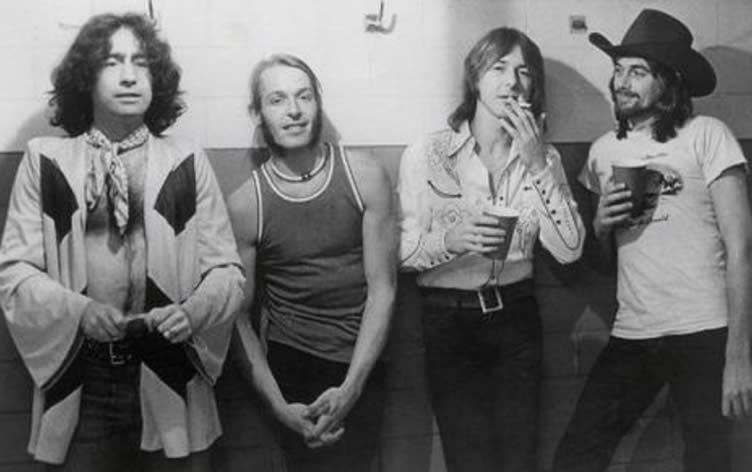Bad Company 1974 debut
 Originally considered a pet project of Led Zeppelin manager Peter Grant and his new label, Swan Song, it took no time for Bad Company to find their own niche in the rock pantheon. The very first album on the label, Bad Company, shot straight to the top of the album charts and has since eclipsed five times platinum, becoming one of the top fifty best selling albums of the seventies along the way. These accomplishments were due to the basic and raw approach to rock and roll, which really struck a chord with mainstream listeners. While hardly visionary, Bad Company‘s sound is distinct, with each of the four players given the space to reach the listener individually and collectively.
Originally considered a pet project of Led Zeppelin manager Peter Grant and his new label, Swan Song, it took no time for Bad Company to find their own niche in the rock pantheon. The very first album on the label, Bad Company, shot straight to the top of the album charts and has since eclipsed five times platinum, becoming one of the top fifty best selling albums of the seventies along the way. These accomplishments were due to the basic and raw approach to rock and roll, which really struck a chord with mainstream listeners. While hardly visionary, Bad Company‘s sound is distinct, with each of the four players given the space to reach the listener individually and collectively.
The group was founded in 1973 when guitarist Mick Ralphs left Mott the Hoople and joined two former members of the rock band Free, drummer Simon Kirke and vocalist Paul Rodgers. When Grant agreed to manage the band, he brought in King Crimson bassist Boz Burrell to complete the quartet. Rodgers’ fascination with the Jeff Bridges film Bad Company as well as a passage from a book of Victorian morals, gave the band its name.
Produced independently, Bad Company was recorded at the centuries old workhouse, Headley Grange, with a mobile studio in late 1973. This was the same location where much of Led Zeppelin’s third and fourth albums (and some holdover songs for Physical Graffiti) were recorded, and owes to the rich, spatial sound of the album.
 Bad Company by Bad Company |
|
|---|---|
| Released: June 26, 1974 (Swan Song) Produced by: Bad Company Recorded: Headley Grange, East Hampshire, England, November 1973 |
|
| Side One | Side Two |
| Can’t Get Enough Rock Steady Ready for Love Don’t Let Me Down |
Bad Company The Way I Choose Movin’ On Seagull |
| Group Musicians | |
| Paul Rogers – Lead Vocals, Guitars, Piano Mick Ralphs – Guitars, Keyboards Boz Burrell – Bass Simon Kirke – Drums |
|
Mick Ralphs composed “Can’t Get Enough”, which became Bad Company’s highest charting and best selling song. The sound and energy of this album is immediately apparent in the interplay between Ralphs and Kirke on this opener and perhaps no other song that follows better captures the dynamics of Bad Company. “Rock Steady” is more blues-rock flavored and not quite as feverishly catchy as the opener (but it is catchy nonetheless). Here, Rodgers’ vocals are more dynamic and the song builds a bit before it ends a bit too abruptly.
Ralphs brought “Ready for Love” over from Mott the Hoople, as he sang a version of that song himself on the 1972, All the Young Dudes. This is the first place where the vibe changes to a more somber theme with soulful vocals by Rodgers and a real place for bassist Burrell to shine before the song dissolves nicely in slow rhythms and piano. “Don’t Let Me Down” is a piano ballad with rich backing vocals and a saxophone by guest musicians. The first collaboration between Rodgers and Ralph, the song features steady beats, minimal guitars (until the lead more than half way through), and is designed to drive home the very simple message –
“Don’t let me down, tell me love can be found…”
The second side begins with “Bad Company”, co-written by Kirke, and completing the odd trifecta of song, artist and album sharing the same title. Perhaps the darkest track on the album, “Bad Company” could’ve been influenced by Alice Cooper musically but is much more soulful vocally. The theatrical, piano-driven verses are interrupted masterfully when the full arrangement kicks in during choruses, led by Ralph’s pristine rock guitar. While Rodgers wrote the song, the blending of guitars is what really shines on “The Way I Choose”, with beats like a slow country waltz and some strategic stop/start timing.

“Movin’ On” comes closest to capturing the rock energy of the opener “Can’t Get Enough”, as a very catchy and accessible rock track. Again, the lyrics and rhythms have much economy but still pack a great punch that is impossible to ignore, and this formula drove the song into the Top 20. “Seagull” is the folk-flavored acoustic closer which maintains a very simple arrangement throughout with only the addition of tambourine half way through. With great vocals, the song seems ready made for a movie soundtrack, but is yet a rather odd way to wrap things up on this album.
Led by Bad Company, Swan Song Records had four albums in the Billboard Top 200 chart less than a year after its launch. This original lineup of the group nearly tracked directly with the lifespan of the label as their final 1982 album Rough Diamonds was the second to last release on the label, which folded in 1983.
~
Part of Classic Rock Review’s celebration of 1974 albums.





Top 9 Rock Journeymen | River of Rock
August 22, 2017 @ 4:18 pm
[…] Right Now” by Free: Bad Company debut album review Straight Shooter by Bad Company album review The Free album […]